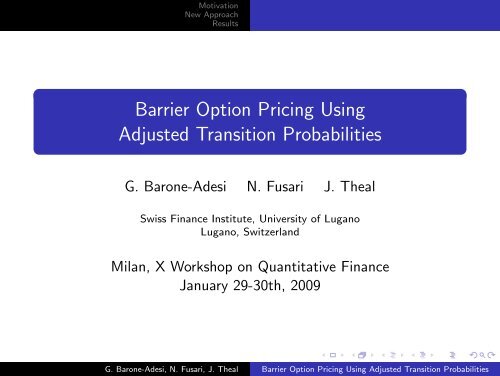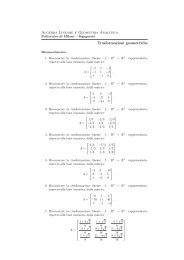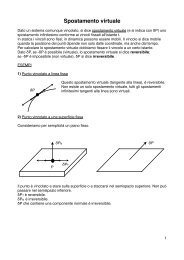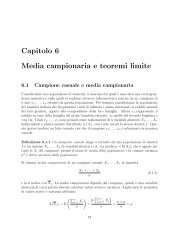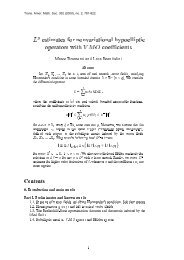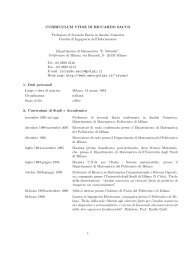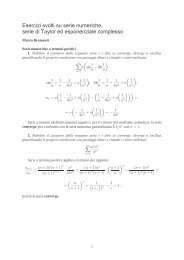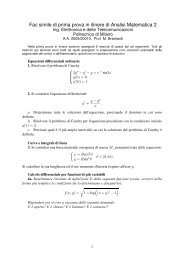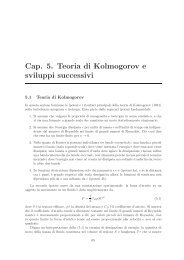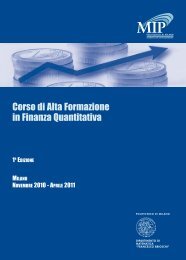Barrier Option Pricing Using Adjusted Transition Probabilities
Barrier Option Pricing Using Adjusted Transition Probabilities
Barrier Option Pricing Using Adjusted Transition Probabilities
Create successful ePaper yourself
Turn your PDF publications into a flip-book with our unique Google optimized e-Paper software.
OutlineMotivationNew ApproachResultsThe standard Cox-Ross-Rubinstein Binomial TreePrevious work1 MotivationThe standard Cox-Ross-Rubinstein Binomial TreePrevious work2 New Approach<strong>Adjusted</strong> Binomial (and Trinomial) Tree3 ResultsComparisonWhat is new?G. Barone-Adesi, N. Fusari, J. Theal <strong>Barrier</strong> <strong>Option</strong> <strong>Pricing</strong> <strong>Using</strong> <strong>Adjusted</strong> <strong>Transition</strong> <strong>Probabilities</strong>
MotivationNew ApproachResultsThe standard Cox-Ross-Rubinstein Binomial TreePrevious workConvergence behaviour of the Standard TreeA barrier option is a path-dependent option whose payoff isdetermined based on whether the price of the undelying assetreaches some pre-determined levelThe convergence of the standard Cox-Ross-RubinsteinBinomial Tree displays an erratic behaviour and a persistentbias in pricing <strong>Barrier</strong> <strong>Option</strong>sThe reason for this behaviour, as pointed out by Boyle (1994),is that “the barrier will in general lie in between two adjacentnodes in the lattice”If the barrier is near to the “starting node”, the standardmethod generates a relevant biasG. Barone-Adesi, N. Fusari, J. Theal <strong>Barrier</strong> <strong>Option</strong> <strong>Pricing</strong> <strong>Using</strong> <strong>Adjusted</strong> <strong>Transition</strong> <strong>Probabilities</strong>
MotivationNew ApproachResultsThe standard Cox-Ross-Rubinstein Binomial TreePrevious workBoyle and Lau (1994) & Ritchken (1995)Revised Binomial-Trinomial TreeIn case of a constant barrier (H), it is easy to constrain thetime partition such that the barrier lies just above a layer ofhorizontal nodes, Boyle and Lau (1994)Ritchken (1995) proposes an extension of the standardtrinomial model. As usual, the issue is to place a layer ofnodes as near as possible (from below) to the barrierRecall that, in the trinomial model, up and down movementsare respectively up = exp ( λσ √ T /n ) anddown = exp ( − λσ √ T /n )For single and double constant barriers it is possible to selectthe stretch parameter λ such that the barrier lies exactly onthe nodesG. Barone-Adesi, N. Fusari, J. Theal <strong>Barrier</strong> <strong>Option</strong> <strong>Pricing</strong> <strong>Using</strong> <strong>Adjusted</strong> <strong>Transition</strong> <strong>Probabilities</strong>
MotivationNew ApproachResultsThe standard Cox-Ross-Rubinstein Binomial TreePrevious workBoyle and Lau (1994) & Ritchken (1995)Revised Binomial-Trinomial TreeIn case of a constant barrier (H), it is easy to constrain thetime partition such that the barrier lies just above a layer ofhorizontal nodes, Boyle and Lau (1994)Ritchken (1995) proposes an extension of the standardtrinomial model. As usual, the issue is to place a layer ofnodes as near as possible (from below) to the barrierRecall that, in the trinomial model, up and down movementsare respectively up = exp ( λσ √ T /n ) anddown = exp ( − λσ √ T /n )For single and double constant barriers it is possible to selectthe stretch parameter λ such that the barrier lies exactly onthe nodesG. Barone-Adesi, N. Fusari, J. Theal <strong>Barrier</strong> <strong>Option</strong> <strong>Pricing</strong> <strong>Using</strong> <strong>Adjusted</strong> <strong>Transition</strong> <strong>Probabilities</strong>
MotivationNew ApproachResultsThe standard Cox-Ross-Rubinstein Binomial TreePrevious workFurther ExtensionsCostabile (2001) proposes a discrete time algorithm for pricingdouble constant barrier optionsCostabile (2002) proposes an extension of theCox-Ross-Rubinstein algorithm for pricing options with anexponential boundaryFiglewsky and Gao (1999) propose an adaptive mesh modelthat can be used to price constant barrier optionsThe problem with these procedures is that they are “ad hoc”solutions to specific cases; we look for a general algorithm thatallows to approximate simple (single constant barrier) as well ascomplex (single and double time-varying) barriers options.G. Barone-Adesi, N. Fusari, J. Theal <strong>Barrier</strong> <strong>Option</strong> <strong>Pricing</strong> <strong>Using</strong> <strong>Adjusted</strong> <strong>Transition</strong> <strong>Probabilities</strong>
MotivationNew ApproachResultsThe standard Cox-Ross-Rubinstein Binomial TreePrevious workFurther ExtensionsCostabile (2001) proposes a discrete time algorithm for pricingdouble constant barrier optionsCostabile (2002) proposes an extension of theCox-Ross-Rubinstein algorithm for pricing options with anexponential boundaryFiglewsky and Gao (1999) propose an adaptive mesh modelthat can be used to price constant barrier optionsThe problem with these procedures is that they are “ad hoc”solutions to specific cases; we look for a general algorithm thatallows to approximate simple (single constant barrier) as well ascomplex (single and double time-varying) barriers options.G. Barone-Adesi, N. Fusari, J. Theal <strong>Barrier</strong> <strong>Option</strong> <strong>Pricing</strong> <strong>Using</strong> <strong>Adjusted</strong> <strong>Transition</strong> <strong>Probabilities</strong>
OutlineMotivationNew ApproachResults<strong>Adjusted</strong> Binomial (and Trinomial) Tree1 MotivationThe standard Cox-Ross-Rubinstein Binomial TreePrevious work2 New Approach<strong>Adjusted</strong> Binomial (and Trinomial) Tree3 ResultsComparisonWhat is new?G. Barone-Adesi, N. Fusari, J. Theal <strong>Barrier</strong> <strong>Option</strong> <strong>Pricing</strong> <strong>Using</strong> <strong>Adjusted</strong> <strong>Transition</strong> <strong>Probabilities</strong>
MotivationNew ApproachResults<strong>Adjusted</strong> Binomial (and Trinomial) TreeProbability AdjustmentBaldi, Caramellino and Iovino (1999) derive a series ofapproximations for the exit probability of the Brownian bridgethat can be used to price multiple and time-varying barriersoptionsRecall that the log of the asset price follows a BrownianMotionBaldi et al. use these probabilities to improve the Monte Carlocalculations, because with the standard procedure it ispossible that the underlying asset price breaches the barrierwithout being detectedHere we use these probabilities to improve theCox-Ross-Rubinstein binomial treeG. Barone-Adesi, N. Fusari, J. Theal <strong>Barrier</strong> <strong>Option</strong> <strong>Pricing</strong> <strong>Using</strong> <strong>Adjusted</strong> <strong>Transition</strong> <strong>Probabilities</strong>
MotivationNew ApproachResultsThe Problem: Paths Detection<strong>Adjusted</strong> Binomial (and Trinomial) TreeThere exist Brownian bridge pahts that cross the barrier. Thesepaths has payoff equat to 0. The standard binomial (trinomial)approach does not detect them.&'(($)'*+!,-#.!/!!$!" #!!&'(($)'*+!,-#.!0!!"#! !%$!"#!!1-22'32!!%!"#!G. Barone-Adesi, N. Fusari, J. Theal <strong>Barrier</strong> <strong>Option</strong> <strong>Pricing</strong> <strong>Using</strong> <strong>Adjusted</strong> <strong>Transition</strong> <strong>Probabilities</strong>
MotivationNew ApproachResults<strong>Adjusted</strong> Binomial (and Trinomial) TreeProcedureA Simple Example: Down-out call (DOC) with constant barrier (1)C T0p upp downC upT 0+δtLThe ”adjustedtree” is similar tothe standard CRRmodel; thedifference relies onthe computationof the value of theoption in thenodes just abovethe barrier.C downT 0+δtG. Barone-Adesi, N. Fusari, J. Theal <strong>Barrier</strong> <strong>Option</strong> <strong>Pricing</strong> <strong>Using</strong> <strong>Adjusted</strong> <strong>Transition</strong> <strong>Probabilities</strong>
MotivationNew ApproachResults<strong>Adjusted</strong> Binomial (and Trinomial) TreeProcedureA Simple Example: Down-out call (DOC) with constant barrier (2)C T0p up (1 − p δtL )p downC upT 0+δtLC downT 0+δt= 0That is, wemultiply the usualprobability ofreaching the uppoint by oneminus theconditionalprobability (pL δt)that the assetsprice, in the timeinterval, hits thebarrier.G. Barone-Adesi, N. Fusari, J. Theal <strong>Barrier</strong> <strong>Option</strong> <strong>Pricing</strong> <strong>Using</strong> <strong>Adjusted</strong> <strong>Transition</strong> <strong>Probabilities</strong>
MotivationNew ApproachResults<strong>Adjusted</strong> Binomial (and Trinomial) TreeProcedureA Simple Example: Down-out call (DOC) with constant barrier (3)= Exit Probability. This is the probability that the assetprice, starting from S T0 and ending in S upT 0+δt, hits the barrierIn this case we have[ ( ) (pL δt (T 0, S T0 , S upT 0+δt, L) = exp − 2σ 2 δt ln S T0 Sup)]Tln0+δtL LpLδtWith this probability adjustment the price of the DOC nearthe barrier (when S downT 0+δt< L), at time T 0 , isC DOC = exp(−rδt)p up (1 − pL δt up)C(ST 0+δt)G. Barone-Adesi, N. Fusari, J. Theal <strong>Barrier</strong> <strong>Option</strong> <strong>Pricing</strong> <strong>Using</strong> <strong>Adjusted</strong> <strong>Transition</strong> <strong>Probabilities</strong>
MotivationNew ApproachResults<strong>Adjusted</strong> Binomial (and Trinomial) TreeProcedureGeneral CaseThe same procedure can be extended to the pricing of morecomplex options with single and multiple time-varying barriers.Baldi at al. provide exit probability approximations for allkinds of time-varying barriersIn the paper we focus on:Single/double constant barriersSingle/double exponential barriersSingle/double (time) linear barriersThis simple procedure avoids the need of repositioning thetree “on the barrier”G. Barone-Adesi, N. Fusari, J. Theal <strong>Barrier</strong> <strong>Option</strong> <strong>Pricing</strong> <strong>Using</strong> <strong>Adjusted</strong> <strong>Transition</strong> <strong>Probabilities</strong>
MotivationNew ApproachResults<strong>Adjusted</strong> Binomial (and Trinomial) TreeExtensionBermudan <strong>Option</strong>Knock-out pathsSafe pathsThese are the paths that mustbe considered in order to applythe transition probabilityadjustment method.safe pathsknock-out pathsDate t discretKnock-out <strong>Barrier</strong>G. Barone-Adesi, N. Fusari, J. Theal <strong>Barrier</strong> <strong>Option</strong> <strong>Pricing</strong> <strong>Using</strong> <strong>Adjusted</strong> <strong>Transition</strong> <strong>Probabilities</strong>
MotivationNew ApproachResults<strong>Adjusted</strong> Binomial (and Trinomial) TreeExtensionBermudan <strong>Option</strong>S0Date t discretKnock-out <strong>Barrier</strong>dS0When the barrier falls betweentwo successive time steps, theprobability adjustment is givenby the cumulative normaldistribution (i.e. theprobability distribution of aBrownian Bridge):µ = a + t − t 1(b − a)t 2 − tσ 2 = (t − t 1)(t 2 − t)t 2 − t 1G. Barone-Adesi, N. Fusari, J. Theal <strong>Barrier</strong> <strong>Option</strong> <strong>Pricing</strong> <strong>Using</strong> <strong>Adjusted</strong> <strong>Transition</strong> <strong>Probabilities</strong>
OutlineMotivationNew ApproachResultsComparisonWhat is new?1 MotivationThe standard Cox-Ross-Rubinstein Binomial TreePrevious work2 New Approach<strong>Adjusted</strong> Binomial (and Trinomial) Tree3 ResultsComparisonWhat is new?G. Barone-Adesi, N. Fusari, J. Theal <strong>Barrier</strong> <strong>Option</strong> <strong>Pricing</strong> <strong>Using</strong> <strong>Adjusted</strong> <strong>Transition</strong> <strong>Probabilities</strong>
MotivationNew ApproachResultsComparisonWhat is new?Down-out Call Price ApproximationNumber of Time Steps in the TreeS 0 500 1000 3000 5000 Alyt. P.94.0 4.849/4.723 4.814/4.839 4.840/4.880 4.820/4.833 4.864(4.863) (4.864) (4.864) (4.864)93.0 3.667/3.610 3.601/3.634 3.641/3.708 3.654/3.703 3.702(3.700) (3.701) (3.701) (3.702)92.0 2.450/2.526 2.509/2.398 2.507/2.497 2.454/2.464 2.506(2.504) (2.506) (2.506) (2.506)91.0 1.222/1.333 1176/1.155 1.221/1.248 1.224/1.272 1.274— (1.274) (1.275) (1.274)90.1 0.127/0.122 0.129/0.122 0.129/0.124 0.137/0.127 0.129— — — — —90.01 0.012/0.012 0.012/0.012 0.012/0.012 0.012/0.012 0.013— — — —Table: K=100, Vol=25%, rf=10%, T=1, L=90, ()=Ritchken’96.G. Barone-Adesi, N. Fusari, J. Theal <strong>Barrier</strong> <strong>Option</strong> <strong>Pricing</strong> <strong>Using</strong> <strong>Adjusted</strong> <strong>Transition</strong> <strong>Probabilities</strong>
MotivationNew ApproachResultsComparisonWhat is new?Double Knock-out Call with Constant <strong>Barrier</strong>sShort Maturity (1 Month - Trinomial Tree): Pellser(2000)Vol U L KI FD Approx1 Approx21500 500 25.12 24.47 25.12 25.12σ = 0.20 1200 800 24.16 24.69 24.77 24.761050 950 2.15 2.15 2.15 2.151500 500 36.58 36.04 36.58 36.58σ = 0.30 1200 800 29.45 29.40 29.40 29.461050 950 0.27 0.27 0.26 0.281500 500 47.58 47.31 47.85 47.84σ = 0.40 1200 800 25.84 25.82 25.88 25.861050 950 0.02 0.01 0.01 0.01Table: U = Upper <strong>Barrier</strong>, L = Lower <strong>Barrier</strong>, KI = Kunitomo and Ikedamethod, FD = Finite Difference method, Approx1 = 1000 steps, Approx2= 2000 steps. Parameters: S 0 =1000, K=1000, rf=5%, T=0.5G. Barone-Adesi, N. Fusari, J. Theal <strong>Barrier</strong> <strong>Option</strong> <strong>Pricing</strong> <strong>Using</strong> <strong>Adjusted</strong> <strong>Transition</strong> <strong>Probabilities</strong>
MotivationNew ApproachResultsComparisonWhat is new?Double Knock-out Call with Constant <strong>Barrier</strong>sGeman and Yor ComparisonTree Lvls. <strong>Option</strong> Value <strong>Option</strong> Value <strong>Option</strong> ValueCase 1 Case 2 Case 31000 0.0412 0.0178 0.07592000 0.0412 0.0178 0.07623000 0.0411 0.0176 0.07554000 0.0411 0.0179 0.07625000 0.0410 0.0178 0.0762Analyt. Value 0.0411 0.0178 0.0761Table: Comparison of results between the adjusted trinomial tree and theanalytical values calculated by Geman and Yor (1996).Case1: S 0 = 2, K = 2, σ = 20%, r = 2%, T = 1y, L = 1.5, U = 2.5Case2: S 0 = 2, K = 2, σ = 50%, r = 5%, T = 1y, L = 1.5, U = 3Case3: S 0 = 2, K = 1.75, σ = 50%, r = 5%, T = 1y, L = 1.5, U = 3G. Barone-Adesi, N. Fusari, J. Theal <strong>Barrier</strong> <strong>Option</strong> <strong>Pricing</strong> <strong>Using</strong> <strong>Adjusted</strong> <strong>Transition</strong> <strong>Probabilities</strong>
MotivationNew ApproachResultsComparisonWhat is new?Down-out Call with Exponential <strong>Barrier</strong>Slope=-0.1Slope=0.1Tree Lvls. Cost. Adj. Tree Lvls Cost. Adj.17 7.002 6.494/6.631 24 5.020 5.581/5.40077 6.958 6.580/6.753 92 4.949 4.993/4.985181 6.920 6.710/6.787 203 4.934 4.926/4.876327 6.910 6.761/6.786 356 4.934 4.907/4.877515 6.912 6.796/6.802 552 4.932 4.902/4.9122100 6.902 6.854/6.868 2174 4.929 4.905/4.9154754 6.900 6.872/6.889 4865 4.929 4.929/4.918Analytic 6.896 Analytic 4.928Table: Comparison of results between the adjusted-probability methodand the extended Cox-Ross-Rubinstein method of Costabile(2002)G. Barone-Adesi, N. Fusari, J. Theal <strong>Barrier</strong> <strong>Option</strong> <strong>Pricing</strong> <strong>Using</strong> <strong>Adjusted</strong> <strong>Transition</strong> <strong>Probabilities</strong>
MotivationNew ApproachResultsComparisonWhat is new?Down-out Call with Linear <strong>Barrier</strong>Convergence BehaviourDouw-out European Call with Linear <strong>Barrier</strong>S=100, K=100, vol=25%, rf=10%, Intercept=95, slope=1010Trinomial Tree (unadjusted)Trinomial Tree (adjusted)98<strong>Option</strong> Price76541 45 89 133 177 221 265 309 353 397 441 485 529 573 617 661 705 749 793 837 881 925 969Number of Steps in TreeG. Barone-Adesi, N. Fusari, J. Theal <strong>Barrier</strong> <strong>Option</strong> <strong>Pricing</strong> <strong>Using</strong> <strong>Adjusted</strong> <strong>Transition</strong> <strong>Probabilities</strong>
MotivationNew ApproachResultsComparisonWhat is new?Down-out Call with Linear <strong>Barrier</strong>Convergence BehaviourDouw-out European Call with Linear <strong>Barrier</strong>S=100, K=100, vol=25%, rf=10%, Intercept=95, slope=1010Trinomial Tree (unadjusted)Trinomial Tree (adjusted)98<strong>Option</strong> Price76541 45 89 133 177 221 265 309 353 397 441 485 529 573 617 661 705 749 793 837 881 925 969Number of Steps in TreeG. Barone-Adesi, N. Fusari, J. Theal <strong>Barrier</strong> <strong>Option</strong> <strong>Pricing</strong> <strong>Using</strong> <strong>Adjusted</strong> <strong>Transition</strong> <strong>Probabilities</strong>
MotivationNew ApproachResultsComparisonWhat is new?Double Knock-out Call with Linear <strong>Barrier</strong>sConvergence Behaviour1.5Down-out European Call with Double Linear <strong>Barrier</strong>sS=100, K=100, vol=25%, rf=10%, L=92, L1=-22, U0=105, U1=105Trinomial Tree (unadjusted)1.3Trinomial Tree (adjusted)1.1<strong>Option</strong> Price0.90.70.50.31 46 91 136 181 226 271 316 361 406 451 496 541 586 631 676 721 766 811 856 901 946 991Number of Steps in TreeG. Barone-Adesi, N. Fusari, J. Theal <strong>Barrier</strong> <strong>Option</strong> <strong>Pricing</strong> <strong>Using</strong> <strong>Adjusted</strong> <strong>Transition</strong> <strong>Probabilities</strong>
MotivationNew ApproachResultsComparisonWhat is new?Double Knock-out Call with Linear <strong>Barrier</strong>sConvergence BehaviourDown-out European Call with Double Linear <strong>Barrier</strong>sS=100, K=100, vol=25%, rf=10%, L=92, L1=-22, U0=105, U1=1051.51.3Trinomial Tree (unadjusted)Trinomial Tree (adjusted)1.1<strong>Option</strong> Price0.90.70.50.31 46 91 136 181 226 271 316 361 406 451 496 541 586 631 676 721 766 811 856 901 946 991Number of Steps in TreeG. Barone-Adesi, N. Fusari, J. Theal <strong>Barrier</strong> <strong>Option</strong> <strong>Pricing</strong> <strong>Using</strong> <strong>Adjusted</strong> <strong>Transition</strong> <strong>Probabilities</strong>
MotivationNew ApproachResultsBermuda <strong>Option</strong>sBroadie, Glasserman and Kou (1997) ComparisonComparisonWhat is new?<strong>Barrier</strong> Corrected Probability True Broadie Rel. Adj. Rel.Continous <strong>Adjusted</strong> Price Error (%) Error (%)85 6.322 6.322 6.322 0 087 6.281 6.281 6.281 0 089 6.184 6.184 6.184 0 091 5.977 5.976 5.977 0 -0.0293 5.585 5.583 5.584 0.02 -0.0295 4.907 4.905 4.907 0 -0.0497 3.836 3.841 3.834 0.05 0.1899 2.271 2.337 2.337 -2.82 0Table: Parameters: S 0 = 100, K = 100, σ = 30%, rf = 10%, T = 0.2.G. Barone-Adesi, N. Fusari, J. Theal <strong>Barrier</strong> <strong>Option</strong> <strong>Pricing</strong> <strong>Using</strong> <strong>Adjusted</strong> <strong>Transition</strong> <strong>Probabilities</strong>
OutlineMotivationNew ApproachResultsComparisonWhat is new?1 MotivationThe standard Cox-Ross-Rubinstein Binomial TreePrevious work2 New Approach<strong>Adjusted</strong> Binomial (and Trinomial) Tree3 ResultsComparisonWhat is new?G. Barone-Adesi, N. Fusari, J. Theal <strong>Barrier</strong> <strong>Option</strong> <strong>Pricing</strong> <strong>Using</strong> <strong>Adjusted</strong> <strong>Transition</strong> <strong>Probabilities</strong>
MotivationNew ApproachResultsComparisonWhat is new?Goals of the Paper and Possible ExtensionsThe “<strong>Adjusted</strong> Tree”:does not require to reposition the tree “on the barrier”demonstrates good convergence properties towards theanalytical price for both single and double constant barriersoptionsproduces an accurate approximation when the stock price isvery close to the barriercan produce price approximation for time-varying barrieroptions including exponential, single linear and double linearbarriersA possible extension concerns the approximation convergencebehaviour: is it possible to obtain monotone convergence?G. Barone-Adesi, N. Fusari, J. Theal <strong>Barrier</strong> <strong>Option</strong> <strong>Pricing</strong> <strong>Using</strong> <strong>Adjusted</strong> <strong>Transition</strong> <strong>Probabilities</strong>


